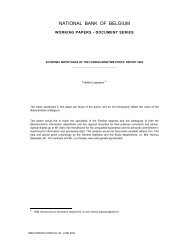Working Paper Research - Nationale Bank van België
Working Paper Research - Nationale Bank van België
Working Paper Research - Nationale Bank van België
Create successful ePaper yourself
Turn your PDF publications into a flip-book with our unique Google optimized e-Paper software.
The collapse of the Bretton Woods system, in the early 1970s, contributed significantly to a shift inthe objectives of central bank cooperation. It went hand in hand with a more general shift from agovernment-led to a market-led financial system (Maes, 2007). With floating exchange rates,increasing capital mobility and financial liberalisation (also inside countries), cooperation shiftedaway from monetary stability towards financial stability (Clement, 2008, p. 6). The high-profilecollapse of certain banks, like Herstatt and Franklin National, helped focus central bankcooperation on the strengthening of international prudential regulation and of payment andsettlement systems. In December 1974, the central bank governors of the G10 countries set up theCommittee on <strong>Bank</strong>ing Regulations and Supervisory Practices (the name was later changed to theBasel Committee on <strong>Bank</strong>ing Supervision). It led to an agreement allocating cross-bordersupervisory responsibilities among member authorities, the so-called "Concordat", in 1975 (Borioand Toniolo, 2008, p. 61). This was followed by the development of good practice guidelines andstandards in all areas of banking regulation and supervision (see Annex 1). A landmark agreementwas the establishment of minimum capital standards, the so-called "Basel Capital Accord" in July1988.5 ALEXANDRE LAMFALUSSY AT THE BIS5.1 A new economic adviser at the BISIn January 1976, Alexandre Lamfalussy joined the <strong>Bank</strong> for International Settlements in Basel asEconomic Adviser and Head of the Monetary and Economic Department. Between 1981 and 1985,he served as Assistant General Manager. He was General Manager from May 1985 until the end of1993.At first sight, the choice of Alexandre Lamfalussy as Economic Adviser might seem somewhatcurious, as he had no central banking or policy-making background 22 . However, "Professor"Lamfalussy had a clear academic background and was well introduced in the internationaleconomic policy-making world. For instance, in 1969, Lamfalussy had given the sixth PerJacobsson Lecture, on the theme The Role of Monetary Gold over the Next Ten Years 23 .Moreover, as a commercial banker, Lamfalussy had a profound knowledge of the financial markets,a big ad<strong>van</strong>tage for a central bank, which always has to be attentive to financial marketdevelopments 24 . Lamfalussy was indeed the right man in the right place. With his knowledge of thefinancial world and his alertness to financial fragility, he was well suited to navigate the BIS and thecentral banking community through the new environment of financial uncertainty.One might remark, in this respect, that Lamfalussy's profile was quite different from that of MiltonGilbert, his predecessor as Economic Adviser. Gilbert, an American, had started his career with22 With the exception of serving on certain committees, like the Segré or De Voghel Committee, cf. supra.23 He was then a commercial banker and just 40 years old.24 For Lamfalussy, as a former commercial banker, the fact that the BIS had also a "<strong>Bank</strong>ing Department"was an important motivation to go there.9
















